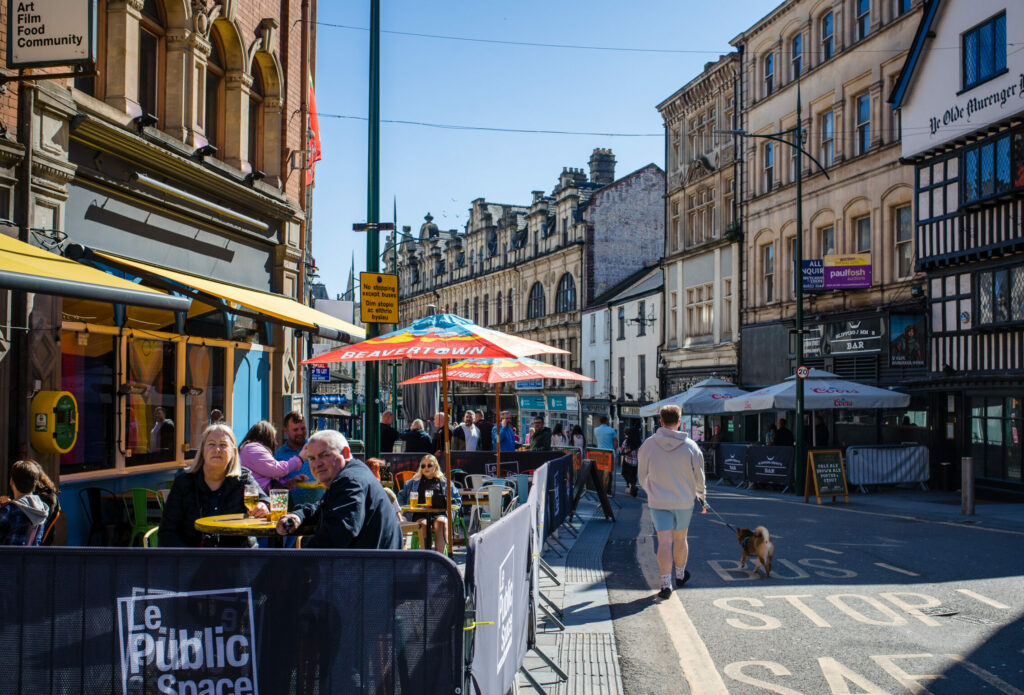Ani Saunders and Ed Thomas Jones investigate the so-called death of the high street and what can be done to revive Welsh town centres.
In her 1969 book The Economies of Cities, Jane Jacobs argued that urban areas are the engine of economic growth because innovation proceeds vigorously in them.
The economy is driven by innovation, or ‘new work’ as Jacobs called it, as the production of new goods and services that replace those that already exist. Urban centres accelerate this process because they are a living ecosystem where the close proximity of people and businesses allows new ideas to flow freely and quickly.
Today, many Welsh urban centres, large and small, are characterised by modest footfalls, derelict shop floors, and boarded-up windows. Despite being a testament to Welsh communities’ historical, cultural, and economic vibrance, these urban centres have been hampered by a series of social, environmental, and economic factors that have caused their development to stall or even reverse in some cases.
The high street: more than a retail space
The focal point of most urban centres is the high street. From the 1940s onwards, the high street became a valuable asset for business activity and land and property values. Shopping was of crucial importance, with prime sites on principal high streets taking on extraordinary value compared to other types of property.
The high street has experienced gradual decline since the 1970s, as local authorities began approving out-of-town developments that brought in additional business rates and enabled them to pedestrianise town centres.
These conditions meant that the nascent post-war property industry was keenly focused on central area shopping as the most lucrative form of redevelopment. Having the best shops and the leading retail chains was seen as an important mark of status and prosperity. Prestigious high streets were viewed by local authorities as a means to demonstrate the importance of their towns, to attract consumers and spending from the surrounding region, and to secure future prosperity.
The high street has experienced gradual decline since the 1970s, as local authorities began approving out-of-town developments that brought in additional business rates and enabled them to pedestrianise town centres. As more people bought their own car, driving to out-of-town shopping centres became fashionable. This trend accelerated as more women, who tended to do the most of the routine shopping at that time, became drivers (Bowlby, 1988).
Syniadau uchelgeisiol, awdurdodol a mentrus.
Ymunwch â ni i gyfrannu at wneud Cymru gwell.
The covid pandemic and associated lockdown that restricted shoppers’ movement further hit the vitality of the high street. Many stores never reopened, as consumers got used to buying on the internet in a few clicks and were hesitant to return to high street shops. BHS, Carpetright, Homebase, House of Fraser, HMV, Maplin, Marks & Spencer, Mothercare, New Look, Toys R Us, Woolworths: a decade ago, this list wouldn’t have looked out of place in the store guide of a well-appointed shopping centre. Today, it reads more like a wall of remembrance commemorating the effects of the pandemic and the casualties suffered in the ongoing battle between the internet and the high street. These victims have either folded completely, been taken over or closed a substantial number of stores in attempts to save cash.
The current problems with urban centres are usually blamed on the rise of internet shopping and the pandemic, but in reality they reflect more serious weaknesses in the economic model which has guided the development of high streets in Wales and across the UK since the mid-twentieth century.
Crisis and contraction in the retail sector poses a fundamental challenge to urban centres all over the country because the prosperity and vitality of these areas has come to rely so heavily upon the local retail economy. The problems are particularly acute in smaller and less affluent towns, although the scale and severity of the retail crisis now means that high streets and shopping districts in many major cities are also under threat.
Reviving the high street
The so-called ‘death of the high street’ has focused political attention upon urban areas and prompted a new wave of policy responses aimed at ‘rescuing’ and ‘regenerating’ flagging high streets. The UK government has announced a series of different measures designed to kickstart regeneration schemes: the Future High Streets Fund, the Towns Fund, the Community Ownership Fund, the Getting Building Fund, the Brownfield Housing Fund, and the Levelling Up Fund.
However, the total amount doesn’t measure up to the size of the problem. Given the funds required to regenerate urban centres across the country most of these funds are designed to facilitate and unlock further investment from the private sector, such as UK pension funds.
Since 2015, the Welsh Government’s Town Centre Loans programme has funded local authorities to support landlords to redevelop empty and underutilised properties and continues to support the transformation of the retail sector through its Together for Retail action plan.
The current problems with urban centres are usually blamed on the rise of internet shopping and the pandemic, but in reality they reflect more serious weaknesses in the economic model which has guided the development of high streets in Wales and across the UK since the mid-twentieth century. Current debates about the decline of the high street raise fundamental questions about what urban centres are actually for, what makes them ‘successful’, and what social and economic functions we wish them to perform.
Through online platforms and mobile apps, people could provide real-time feedback on services and even participate in decision-making to influence the area.
Creating a real and sustained change
The Welsh urban centres, large and small, need a revolution, starting with revitalising their flagging high streets. A first step could be using technology to create intelligent (or smart) urban centres to connect peripheral districts and high streets.
Technologies such as IoT sensors and AI can improve the quality of life of occupants and visitors, improve the efficiency of public services and infrastructures, and promote the environment and sustainability. Advanced technologies could be integrated into all activities, from energy supply to traffic management, waste to water resource management, to public safety. This would make it possible to improve the quality of services, reduce costs and increase the overall efficiency of the area, resulting in resilient high streets ready to meet the challenges of the future. Through online platforms and mobile apps, people could provide real-time feedback on services and even participate in decision-making to influence the area.
But to make a real change to our urban centres, we need to ask new questions about their social and economic purpose. There is a growing awareness of the need to develop local assets for the local community and ensure accessibility to services and experiences regardless of income, age, ability, or background. Community-led ventures have the capacity to shift the power dynamics from a top-down approach to tackling local urban problems to a more bottom-up one where the community decides what’s best for them. Places bringing people together can become the focal points of communities and help enhance the quality of life for those living there. Once new initiatives have been sparked, community action has the ability to create new energy and dynamism.
Gofod i drafod, dadlau, ac ymchwilio.
Cefnogwch brif felin drafod annibynnol Cymru.
Empowering local authorities to compulsorily purchase sites at below market value as this would address the problem of overpriced and under-used properties on the high street, and then allow these to be used by the community to provide a social benefit. There have been a number of modest moves in this direction, including the opening up of vacant property to community groups and the promotion of various forms of temporary, often low-value commercial activity in urban centres.
The importance of community-led ventures
The idea of communities taking ownership of local assets (through buying, leasing, managing or even creating something new from scratch) is not new. Over 400 years ago the Diggers (a group of religious and political dissidents in England) took on under-used land for the common good. Early charitable organisations owned land and buildings to support poor people. The collective ownership of assets also had roots in the co-operative and mutual tradition of shared ownership by members. Settlements and social action centres, community centres and village halls have frequently managed a building as part of delivering their service.
Across the whole of Wales, more communities are taking the initiative to purchase assets of local interest and ensure they are operated for the long-term benefit of those communities. There are plenty of examples of community-led ventures in Wales that provide an invaluable service and benefit to local people. Yr Iorwerth Arms in Bryngwran (Anglesey), Partneriaeth Ogwen in Bethesda (Gwynedd), Pwllglas Community Shop in Ruthin (Denbighshire), Llanfechain Community Shop in Llanfechain (Powys), Tafarn Sinc in Clynderwen (Pembrokeshire), Siop y Parc near Aberystwyth (Ceredigion) and Glaeri (Caernarfon – the largest community owned venture in Wales) are just some examples of community-led ventures across Wales.
Each kind of community venture has intrinsic value, either for its contribution to various social goods, including collective and individual well-being, cultural identity or participation, or for its economic value. As interest in local wealth building grows, community-led ventures should be part of the activities designed to grow local shared wealth, especially in economically disadvantaged places.
These ventures, and others across Wales, have brought a sense of purpose and achievement, provided an appreciation of local and national history, and renewed and boosted the sense of community. Some have been successful in generating a new social identity of the local community, connecting people who might otherwise have remained anonymous neighbours, and have preserved a significant place which represents for them a cornerstone in their community history.
Most of all, being part of such ventures enhances the experience of being part of a community, one that works together for the common good, building something positive and lasting for the future.
The case of Wrexham
Wrexham is a proud market town located in northeast Wales. Whilst the story of its decline post-industry echoes those uttered throughout this island, its journey towards change is rather more unique.
When studying the dynamics of urban centres from a regeneration point of view, the complex nature of their social and economic value becomes increasingly apparent. For example, in Wrexham, the weekly open-air markets that took place, such as the Beast Market, would bring many people to the town centre. However, not all were there to partake in retail activity, for these markets were also well-established social events with many gathering in nearby cafes, pubs and restaurants to soak in the atmosphere.
Empty shops on the high street provided the space and opportunity for local students and artists to build their capacity as creatives and as a community. They began organising events and gatherings – such as art shows and live music – which started bringing people back into the town centre, thereby generating a new sense of vitality and vibrancy within the town.
Without such events to bring people together, spaces such as high streets lose their value, both social and economic. To put it simply, people will not go there and whilst a dwindling high street reflects the economic climate of a place, it also reflects the loss of an embedded sense of community built by the locals over several generations. Shops can be replaced, but the social dynamics that allow them to flourish cannot be reproduced easily.
So what has Wrexham been doing differently to address this? Over the past decade or so, the town has seen a significant rise in arts and culture-based activity, and this is down to a number of factors. For example, music courses and an increasing number of art courses at the local college and university resulted in a growing community of students studying creative and cultural disciplines while living in Wrexham. Lower living costs compared to nearby cities such as Liverpool and Manchester meant that they also began staying in the town after graduating.
Whilst the arts and music scenes have always had a presence in Wrexham, historically they have been fairly fragmented. However, there was a recognition that by bringing people from all sorts of artistic disciplines together, benefits would ripple outwards to the wider community. Empty shops on the high street provided the space and opportunity for local students and artists to build their capacity as creatives and as a community. They began organising events and gatherings – such as art shows and live music – which started bringing people back into the town centre, thereby generating a new sense of vitality and vibrancy within the town.
For example, Focus Wales (established in 2011) is an international music showcase festival taking place in venues across the town. It provides a platform for emerging musical talent from Wales and beyond and attracts over 20,000 people to Wrexham each year. One of the host venues of Focus Wales is Tŷ Pawb, which opened in 2018. Formerly the site of the People’s Market, it is a cultural community centre and arts hub that comprises a gallery, food hall, and market stalls. It is one example of the way in which the local authority has recognised the value of utilising arts and culture as a way of bringing people together. In addition to increasing footfall in the town centre, the festival contributes to community cohesion.
It would be remiss to talk about the transformation of Wrexham without mentioning Wrexham AFC. Over the past 150 years or so, a significant part of the town’s culture has revolved around football. Wrexham AFC has been the one constant throughout the town’s highs and lows. And whilst it too has seen periods of significant decline, its more recent highs should not be seen in isolation. It in fact is just as reflective of the growth in the town’s overall confidence and sense of self than it is of any financial investment. Of course, the arts and football are mere examples of how one place is building a momentum for change. For other places, other ways of generating change may be more suitable and relevant, depending on what people there value and want.
The solutions are already here
Not only was Jane Jacobs an influential academic, she was also a passionate activist that organised grassroots efforts to renew urban centres. She routinely criticised experts that implemented top-down solutions to urban problems. Jacobs believed, and proved through her work, that the solutions to many of the problems faced in cities and towns were already known by the people living in those communities. Only through honest active engagement with these communities do impactful solutions surface. This bottom-up approach to urban revival relies on creating the infrastructure and support system that allows communities to propose and develop their own solutions.
Urban centres are more than just an economic space full of generic retail units; they can be a social space that are vibrant, dynamic living beings and ecosystems that are overflowing with ideas. People crave human interaction and want to feel that they are part of the community. Urban centres that can offer a reason for people to visit will drive community cohesion, create spaces for interactions, and help create an open society that is welcoming of different views and ideas. Our national economic prosperity depends on such openness.
All articles published on the welsh agenda are subject to IWA’s disclaimer. If you want to support our work tackling Wales’ key challenges, consider becoming a member.





